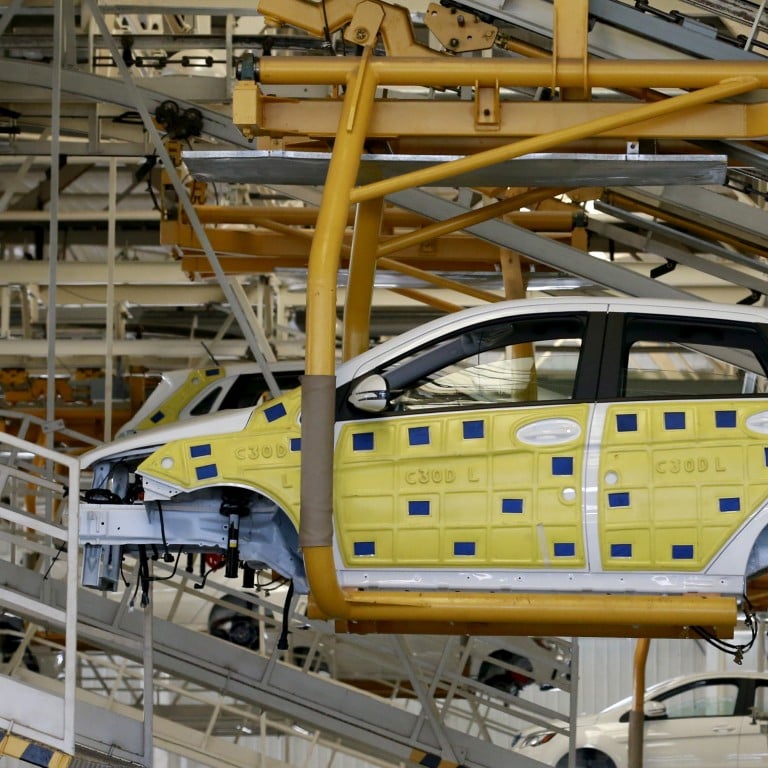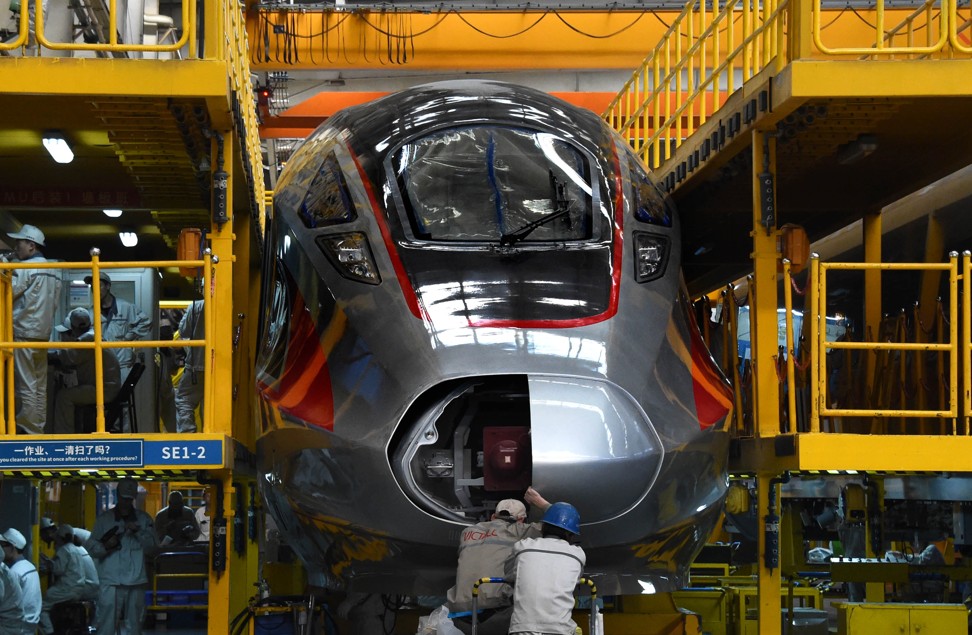
China’s new industrial policy dismissed as ‘Made in China 2025’ rehash by critics in Washington
- New plan seeks to meld ‘smart’ manufacturing with ‘modern’ internet
- Like ‘Made In China 2025’ plan, it would seek to create national champions by 2025
This story is part of an ongoing series on US-China relations produced jointly by the South China Morning Post and POLITICO, with reporting from Asia and the United States.
China went back to the drawing board to create a new plan to grow its industries. But to many hardliners in the United States, it seems to be a copy-and-paste job of the old plan.
Last Friday, Beijing announced a policy to upgrade and integrate China’s manufacturing sector with a “modern” service sector to respond to rapidly changing demand, according to an official document.
The document provides further evidence that US President Donald Trump’s bruising trade war and aggressive tactics have done little to change China’s drive to dominate new technology with state support. It also underscores the broader challenge Trump faces in his attempt to tame a government-driven economic development model that exists outside the free market.
The main message I get from this is: We’re pursuing a state-led, large firm development goal
“The main message I get from this is: We’re pursuing a state-led, large firm development goal,” said Derek Scissors, a senior fellow and China economy expert at the American Enterprise Institute.
“They don’t say anything about competition in here at all. The messaging is entirely consistent with Made in China 2025,” he added.
Made in China 2025 was attacked by officials in the US and European Union, who said it was merely a conduit to use government funds to gain competitive advantages, often flouting global trading rules in the process.
Indeed, the new policy guidance contains many of the same goals as the so-called Made in China 2025 strategy that Beijing launched in 2015 to achieve global dominance in 10 sectors including robotics, aircraft, pharmaceuticals and other industries.
The Trump administration specifically criticised that initiative in an investigation that has led to US tariffs on roughly $360 billion in Chinese goods.
“A key part of China’s technology drive involves the acquisition of foreign technologies through acts, policies, and practices by the Chinese government that are unreasonable or discriminatory and burden or restrict US commerce,” the US trade representative’s office (USTR) said in its original inquiry into China’s industrial practices.
“At one point they gave up talking about [Made in] China 2025,” said Huang Yasheng, who heads the China Lab at MIT Sloan School of Management, at a forum organised by the National Committee on US-China Relations in Washington on Monday.
“Now China 2025 has come back,” he said. “I think they made a calculation that it was not terribly useful to continue with the conversations with President Trump – they just give up on that.”
Now China 2025 has come back. I think they made a calculation that it was not terribly useful to continue with the conversations with President Trump – they just give up on that
Meng Wei, spokeswoman for the National Development and Reform Commission (NDRC), China’s top economic planning agency, said that certain companies would play the main roles in implementing the new plan. She named Huawei Technologies, which has been subjected to US sanctions and export controls, as well as large tech companies like NetEase and Xiaomi.
“But the government must do something as well, to provide a better development environment. In the next step we will focus on implementation to resolve barriers that restrict the integration of the two sectors,” Meng said during a press conference last Friday.
The latest policy document doesn’t mention the same 10 sectors the Made in China initiative targeted but puts the same 2025 deadline for forming a group of “deeply-integrated” enterprises focused on “smart factories” with better connectivity through the internet and supply chain optimisation.
The new plan would “form a group of enterprises, platforms and pilot zones that deeply integrate” the manufacturing and service sectors, according to the guideline document released on Friday jointly by the NDRC and 14 other central government departments.
Instead of using direct government cash subsidies, it calls for support to come from long-term bank loans as well as grants of land by local governments. However, China hawks in Washington claim it is another example of China state sponsoring its way to success.
“It was never going to happen that we were going to get China to renounce an industrial policy that says we want to advance technologically by any means necessary,” Scissors said.
Still, China has seemed to double-down on achieving technological prowess for the future.
For example, the new guidelines call for the automotive sector to enhance data mining to better understand traffic patterns so that China can push forward with rolling out electric vehicle charging stations in optimal locations.
It also presses equipment manufacturers to transform themselves from simple systems integrators to providers of more comprehensive business solutions.
“What this ‘implementing idea’ does is propose that the government work on strengthening 10 kinds of business models and operating systems that are applicable across a whole host of industries,” said Scott Kennedy, a senior adviser and China economy expert at the Centre for Strategic and International Studies.
He said the document doesn’t appear to be a successor to the Made in China 2025 initiative, but still unanswered is whether Beijing will use “market-friendly approaches” to achieve the plan’s goals rather than rely on government intervention at the expense of foreign competition.
President Xi Jinping’s record over his over his first seven years “does not inspire confidence they’ll follow a market-friendly approach, but these days one should always be open to expecting the unexpected,” Kennedy said.
Others more critical of the plan saw it as a thin veneer to Chinese practices the US had targeted through its trade fight.
“The Chinese are still not convinced they have to change their playbook in more than a tactical way,” said one person who has been close to the trade talks and asked for anonymity because of their sensitive nature. “They deserve a lot of credit for working overtime to pull the wool over the world’s eyes. It’s truly remarkable.”
The White House and USTR did not reply to an inquiry about the document and its impact on the trade talks.
One of Beijing’s top economic priorities is improving the productivity and innovation in China’s traditional manufacturing sectors to support long-term economic growth.

Higher costs for labour, land, raw materials and taxes have eroded the advantages that made China the “factory of the world,” with many firms in labour-intensive industries moving out of the country to remain competitive. US tariffs on Chinese exports have only exacerbated this trend.
The growth rate of Chinese industrial production has slowed substantially in the past year to 4.7 per cent in October, down from 5.4 per cent in September.
Chinese Premier Li Keqiang said at a symposium last Thursday that additional effort is needed to support advanced manufacturing and the emerging service industries to unleash the potential of the Chinese market.
Chinese analysts have defended the plan. Zhang Yansheng, chief research fellow at the government-affiliated China Centre for International Economic Exchanges think tank, said that Beijing should ignore the negative commentary.
“To do our own things well, you should not choose what you can and cannot do just because someone else said something,” Zhang said. “We should do whatever is good for us, while not listening to others’ judgments, which are meaningless. We should just focus on your own strategic goals and policy instruments.”
Orange Wang reports for the South China Morning Post from Beijing and Adam Behsudi reports for Politico from Washington, DC
Additional reporting by Finbarr Bermingham for the South China Morning Post from Hong Kong

